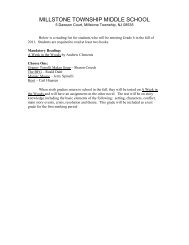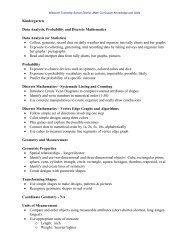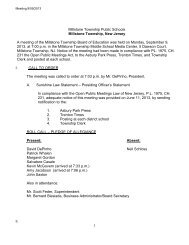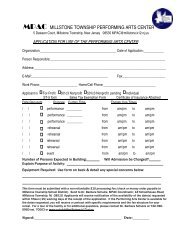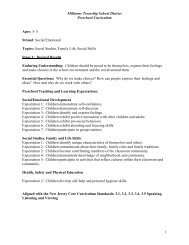You also want an ePaper? Increase the reach of your titles
YUMPU automatically turns print PDFs into web optimized ePapers that Google loves.
Name ___________________________________________Period _____<br />
<strong>Metric</strong> <strong>Mania</strong>!<br />
Upon completion of this packet, you will be a certified<br />
“metricologist!”<br />
(That’s a person who studies the metric system.)<br />
But, before we get there let’s lay down some ground rules:<br />
♦ All equipment is treated with the same care that you would use when handling a prized possession.<br />
♦ All numbers must be accompanied by the appropriate unit. No unit, no credit!<br />
♦ If this packet is lost, your grade will suffer a TEN point deduction!<br />
♦ When moving the triple beam balance, use TWO hands.<br />
♦ Rulers and meter sticks are NOT swords!<br />
Objectives:<br />
♦ Describe the relative size of basic units of metric measure in relation to common objects. 5.3.8.B1<br />
♦ Use correct metric units when referring to metric measures. 5.3.8.B1<br />
♦ Determine the mass of an object using a balance. 5.6.6.A2 & 5.1.8.A2<br />
♦ Determine the volume of a liquid using graduated cylinder. 5.6.6.A2, 5.1.8.A1 & C1,C2<br />
♦ Determine the volume of a rectangular solid. 5.3.8.B1 & C1 & 5.1.8.A1<br />
♦ Recognize density as a characteristic property of matter. 5.6.6.A4<br />
♦ Calculate density given mass and volume. 5.3.8.B1 & C1<br />
♦ Use density to determine whether an object sinks or floats in water. 5.3.8.C1
Name _________________________________________________ Period __________<br />
<strong>Metric</strong> <strong>Mania</strong>: Introduction to Conversions<br />
Common Conversions to remember:<br />
(these conversations all use meters,<br />
but would be the same for liters or grams)<br />
♦<br />
♦<br />
♦<br />
♦<br />
1 m = 1000 mm<br />
1 m = 100 cm<br />
1000 m = 1 km<br />
1 cm = 10 mm<br />
Steps:<br />
• write down your common<br />
conversion (CC)<br />
• Solve<br />
For example:<br />
♦ 17kg = _____ g<br />
if 1 kg = 1,000 g,<br />
then 17 kg = 17,000<br />
♦ 130 mL = _____L<br />
CC: 1000 mL = 1 L<br />
130 mL = .130 L<br />
(Hint: Count your zeroes in your<br />
common conversion…that will tell<br />
you how many times to move your<br />
decimal!)<br />
Try these conversions.<br />
1000 mg = _______ g 1 L = _______ mL<br />
CC: _________________<br />
CC: _________________<br />
160 cm = _______ mm 14 km = _______ m<br />
CC: _________________<br />
CC: _________________<br />
109 g = _______ kg 250 m = _______ km<br />
CC: _________________<br />
CC: _________________<br />
Compare using , or =. (Hint: you want to compare cookies to cookies)<br />
56 cm 6 m 7 g 698 mg<br />
CC: _________________<br />
CC: _________________<br />
(from T. Trimpe 2000 http://sciencespot.net/)
Name _________________________________________________ Period __________<br />
<strong>Metric</strong> <strong>Mania</strong>: Conversion Challenge<br />
Write the correct abbreviation for each metric unit.<br />
1) Kilogram _____ 4) Milliliter _____ 7) Kilometer _____<br />
2) Meter _____ 5) Millimeter _____ 8) Centimeter _____<br />
3) Gram _____ 6) Liter _____ 9) Milligram _____<br />
Try these conversions.<br />
10) 2000 mg = _______ g 13) 5 L = _______ mL 16) 16 cm = _______ mm<br />
CC: _________________ CC: _________________ CC: _________________<br />
11) 104 km = _______ m 14) 198 g = _______ kg 17) 2500 m = _______ km<br />
CC: _________________ CC: _________________ CC: _________________<br />
12) 480 cm = _____ m 15) 75 mL = _____ L 18) 65 g = _____ mg<br />
CC: _________________ CC: _________________ CC: _________________<br />
Compare using , or =.<br />
19) 63 cm 6 m 21) 5 g 508 mg 23) 1,500 mL 1.5 L<br />
CC: _________________ CC: _________________ CC: _________________<br />
20) 536 cm 53.6 m 22) 43 mg 5 g 24) 3.6 m 36 cm<br />
CC: _________________ CC: _________________ CC: _________________<br />
(from T. Trimpe 2000 http://sciencespot.net/)
Name _________________________________________________ Period __________<br />
1. What does each unit represent?<br />
<strong>Metric</strong> <strong>Mania</strong>: Length Lab<br />
(a) mm = ________________________<br />
(c) cm = ________________________<br />
(b) m = ________________________<br />
(d) km = ________________________<br />
2. How much does each one equal?<br />
(a) 1 m = _______ cm (b) 1 cm = _______ mm (c) 1 km = _______ m<br />
3. Which measurement is the largest? Circle your answer for each pair.<br />
(a) 14 mm or 1 cm (d) 145 m or 145 km<br />
CC: _________________<br />
CC: _________________<br />
(b) 334 m or 1 km (e) 3.4 cm or 30 mm<br />
CC: _________________<br />
CC: _________________<br />
(c) 1 m or 990 cm (f) 10 km or 1000 cm<br />
CC: _________________<br />
CC: _________________<br />
4. Use a metric ruler to find each measurement.<br />
ALL ANSWERS MUST INCLUDE THE CORRECT UNITS FOR CREDIT…NO UNIT, NO CREDIT!<br />
If it says “nearest”, you need to round your answer so you don’t have a decimal point. If not, you should<br />
have one decimal point in your answer.<br />
(a) Length of the line above in centimeters ______<br />
(b) Length of the line above to the nearest centimeter _______<br />
(c) Height of the rectangle above to the nearest millimeter _______<br />
(d) Width of the rectangle above to the nearest millimeter _______<br />
(e) Radius of the circle to the nearest millimeter _______<br />
(f) Diameter of the circle in centimeters ________<br />
(g) Diameter of the circle to the nearest centimeter _______<br />
(from T. Trimpe 2000 http://sciencespot.net/)
Name _________________________________________________ Period __________<br />
(h) Volume of the box above in cubic centimeters<br />
________ x ________ x ________ = _________<br />
(Measure to the nearest centimeter before multiplying)<br />
5. Find the length of your pencil (including eraser) in millimeters. ________<br />
6. What is your height in centimeters? ________ What is your height in meters? _______<br />
7. Find the distance between the letters “A” and “B” in the back of the classroom in meters. ________<br />
8. Use your shoe and a metric ruler to complete this section. Keep your shoes on for this one!<br />
(a) What is the length of your shoe to the nearest centimeter? ________<br />
(b) About how many shoes would it take (heel to toe) to make 1 meter? _______<br />
(c) About how many shoes would it take to make 1 kilometer? ________<br />
9. A stack of ten pennies is about 1.4 cm tall.<br />
(a) How tall would a stack of 100 pennies be in centimeters? ________<br />
(b) How tall would a stack of 1000 pennies be in centimeters? _______<br />
10. Circle the BEST metric unit for each.<br />
(a) The length of an eyelash mm cm m km<br />
(b) The height of a flagpole mm cm m km<br />
(c) The length of a strand of spaghetti mm cm m km<br />
(d) The distance from Chicago, IL, to Peoria, IL. mm cm m km<br />
(from T. Trimpe 2000 http://sciencespot.net/)
Name _________________________________________________ Period __________<br />
<strong>Metric</strong> <strong>Mania</strong>: Volume Lab<br />
Part A: Count your drops!<br />
Follow the directions to find the number of drops in 1 milliliter of water, and then answer the questions. You<br />
will need a small graduated cylinder (10 ml), a beaker of water, and an eyedropper for this section.<br />
Practice with the eyedropper before you begin.<br />
Take a guess - How many drops of water will it take to equal 1 milliliter? __________ drops<br />
(1) Fill your eyedropper with water from your beaker.<br />
(2) Using your graduated cylinder, slowly add drops of water, counting as you go. When you get to the<br />
1 ml mark, stop and record the number of drops in the table below<br />
(3) Leave the water in the graduated cylinder. Starting at 1 and count the number of drops it takes to<br />
raise the water to 2 ml. Record the number in the chart.<br />
(4) Repeat for 3 ml, 4 ml, and 5 ml.<br />
(5) Using a calculator, calculate your average and round to the nearest tenth.<br />
Number of<br />
drops to 1 ml<br />
Number of<br />
drops to 2 ml<br />
Number of<br />
drops to 3 ml<br />
Number of<br />
drops to 4 ml<br />
Number of<br />
drops to 5 ml<br />
Average<br />
Based on your average, how close were you to your guess? ____________<br />
Based on your average, how many drops would it take to make 1 liter? _________<br />
Part B: Water Displacement<br />
Follow the directions to find the volume of irregular objects using water displacement.<br />
(1) Add 20 ml of water to a 100 ml graduated cylinder. Record this amount in the chart.<br />
(2) Add the objects to the cylinder and measure the volume. Record this amount in the chart.<br />
(3) Find the difference between the two measurements and record in the chart. The difference between<br />
the two measurements will be the volume of the objects.<br />
(4) Volume can be calculated using liters or meters cubed. The conversion is 1 ml = 1 cm 3 .<br />
Volume of water without<br />
the objects (ml)<br />
Volume of water with<br />
the objects (ml)<br />
Difference in volume /<br />
Volume of objects (ml)<br />
Volume of objects in<br />
cm 3<br />
Part C: Volume by Formula<br />
Use the formula to find the volume of the box in cm 3 . Measure to the nearest centimeter (no decimals)<br />
before calculating your answer.<br />
Volume = length x width x height<br />
__________ x __________ x __________ =______________<br />
(from T. Trimpe 2000 http://sciencespot.net/)
Name _________________________________________________ Period __________<br />
<strong>Metric</strong> <strong>Mania</strong>: Mix & Match Mass<br />
Choose items from the classroom that will be closest to the targeted mass. You may use a single item or<br />
mix and match items to reach the targeted mass, but each group much be a new combination (so if you find<br />
that a paper clip is one gram, you cannot just use 5 paper clips for 5g and 10 for 10g, and so on).<br />
Be sure to go in order and learn from your mistakes. Even if you are off by a lot, still record the actual<br />
mass and move on to the next targeted mass.<br />
Targeted Mass Item(s) Actual Mass<br />
1 gram<br />
5 grams<br />
10 grams<br />
20 grams<br />
50 grams<br />
100 grams<br />
200 grams<br />
400 grams<br />
Circle the BEST metric unit for each.<br />
(1) Your mass: mg g kg<br />
(2) Amount of spices in a batch of cookies: mg g kg<br />
(3) Mass of 10 pennies: mg g kg<br />
Mass Challenge: Use your knowledge of the metric system and lab equipment to answer the question. Be<br />
sure to explain your procedure - how you found your answer!<br />
What is the mass of 100 milliliters of water? ________________<br />
Procedure: ___________________________________________________________________________<br />
_____________________________________________________________________________________<br />
_____________________________________________________________________________________<br />
_____________________________________________________________________________________<br />
(from T. Trimpe 2000 http://sciencespot.net/)
Name _________________________________________________ Period __________<br />
Explore Density<br />
Mass is how much stuff is in an object (or more scientifically, how much matter is in an object).<br />
Volume is how much space an object takes up (or how much space an object occupies).<br />
Density is the amount of stuff in a particular space (or how tightly packed the matter is within an object).<br />
FYI: Density is represented by the Greek letter: ρ (pronounced rho).<br />
Find three water proof things and fill in the table below:<br />
Object<br />
Mass in g<br />
(Use the triple<br />
beam balance)<br />
Volume in mL<br />
(Use the water<br />
displacement<br />
method)<br />
Density in g/mL<br />
(Using the<br />
calculator, do mass<br />
divided by volume)<br />
Sink, suspend, or<br />
float<br />
in water, which has<br />
a density of 1 g/mL<br />
Fun Fact: According to a scientist named Schwarzschild, black holes have a density of 2 * 10 23 g/mL, that’s<br />
200,000,000,000,000,000,000,000 g/mL!<br />
(from T. Trimpe 2000 http://sciencespot.net/)
Name _________________________________________________ Period __________<br />
<strong>Metric</strong> <strong>Mania</strong>: Mystery Canisters<br />
Part A: Use your knowledge of the metric system and lab equipment to modify three vials. One vial should<br />
float (1), another should remain suspended in the middle of the tank (2), and another should sink to the<br />
bottom (3).<br />
Record the mass and volume of each canister in the chart below and calculate the density for each.<br />
Vial 1 (float)<br />
Mass (g) Volume (mL) Density (g/mL)<br />
Vial 2 (suspend)<br />
Vial 3 (sink)<br />
Part B: Based on each density, predict the location of each item in a tub of tap water.<br />
Choose from: float, sink, or suspended.<br />
A. 0.2 g/ml _________________________ D. 1.0 g/ml _________________________<br />
B. 2.3 g/ml _________________________ E. 0.5 g/ml _________________________<br />
C. 0.99 g/ml _________________________ F. 1.9 g/ml _________________________<br />
(from T. Trimpe 2000 http://sciencespot.net/)



